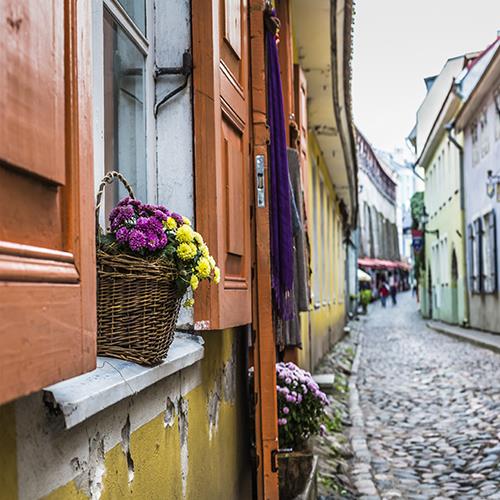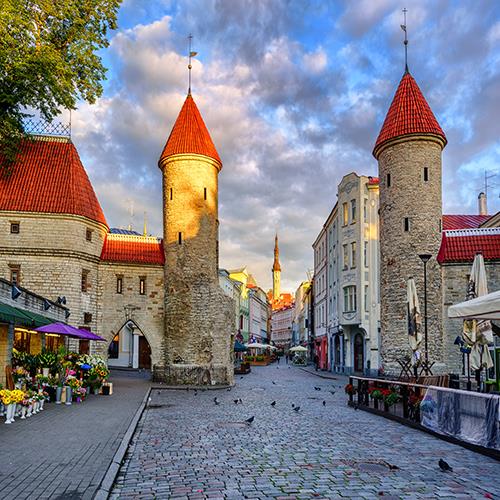EXPERIENCE TALLINN

Overview
Situated along the Baltic Sea, Tallinn is Estonia’s capital city and a renowned tech-hub in Europe, though you wouldn’t know it at first glance. With its picturesque alleys, beautifully preserved historic center, and medieval architecture, the city exudes charm and character. Despite being the largest city in the country, Tallinn maintains a small-town feel offering a delightful blend of quaint streets, vibrant colors, and timeless charm. The city’s compact size makes it easy to explore, whether wandering through its charming alleys, visiting medieval landmarks like Toompea Castle and Alexander Nevsky Cathedral, or enjoying stunning views from its hilltop vantage points. In addition to the Old Town, trendy districts like Telliskivi Creative City showcase Tallinn’s contemporary side, featuring stylish cafes, art spaces, and a lively nightlife. With its rich history, progressive spirit, and scenic coastal setting, Tallinn offers a seamless blend of old-world charm and modern innovation.






Things to See & Do
Explore the picturesque Old town. Take in the atmosphere of the medieval city complete with ancient city walls made from limestone, a beautiful town hall, and brightly colored buildings that line the cobblestone streets.
The town provides a free walking tour of the historic area, offering a fantastic opportunity to explore its main sights while delving into its rich history. From medieval tales of executioners roaming the streets to intriguing stories of the KGB and Soviet spies, these tours bring the past to life, adding depth and intrigue to the sightseeing experience.
Make sure to visit the distinctive circular stone in Town Hall Square. Standing here gives you the best vantage point to see the steeples of five historic churches around Tallinn. Then head inside the church-like Town Hall, built in 1404, the oldest town hall in Northern Europe, where you`ll discover fantastic Gothic arches and beautiful artworks.
B
Another highlight in Tallinn`s Old Town is the Viru Gate. Once part of the city wall`s defense system,. This 14th-century structure features fairy-tale-esque, round towers topped with coned roofs fit for a princess. It is also possible to walk a section of the city walls which connect the Nunna, Sauna and Kuldjala towers. Get an interesting vantage point and soak in the fairy tale charm of Tallinn, while gaining the perspective of the guards that used to roam the walkways, guarding the town against medieval invaders.
Discover the Creative City, a dynamic contrast to Tallinn’s historic center and one of its most vibrant districts. Don’t miss Balti Jaama Turg, a modern indoor-outdoor market offering everything from fresh local produce to unique antiques and diverse eateries. The outdoor section comes alive each morning with local farmers and vendors selling fresh vegetables, homemade jellies, and pickles. Inside, you'll find an array of permanent shops, including a large grocery store, butcher, cupcake shop, and wine boutique. Venture upstairs to explore stalls featuring local artists and designers, from jewelry makers and screen printers to a variety of creative artisans.
Continue your exploration of this neighborhood to enjoy the street art viewing. You could spend several hours just admiring the incredible street art murals. There are vibrant graffiti-style pieces, tongue-and-cheek cartoon pieces, politically charged murals and 3-D installations. After spending some time in this area, you`ll surely understand where the name Creative city comes from. The neighborhood is also home to many great pop-up restaurants built into shipping containers, refurbished Soviet-era watch towers, and public art installations.
Discover the KGB Museum and Museum of Occupations. You`ll get a glimpse into what it felt like to be living in the Soviet region during the Cold War era, a dark time in Estonia`s history. In the 1970`s, the Viru Hotel in central Tallinn was the only hotel where foreigners were allowed to stay, and the KGB had a secret spy base on the 23rd floor to keep tabs on everyone. The KGB museum is built inside this base, retaining many of the KGB artifacts exactly as they were during the Cold War. You will be up close and personal with the equipment used by the KGB agents. Note: you will be required to pre-book tickets to this museum.
Another great area to explore in town is the Rotermanni Quarter. Tucked away in the downtown commercial area, this shopping and restaurant area offers a mix of new construction modern architecture and old industrial warehouses. There are many restaurants in this area to enjoy some excellent regional cuisine.
Visit the Estonian Maritime Museum, a fascinating tribute to the country’s deep-rooted seafaring heritage, shaped by its more than 2,300 islands. Housed in a historic 500-year-old building, the museum offers a unique glimpse into Estonia’s maritime past. Step inside the Submarine EML Lembit, a rare 1930s-era vessel, or climb aboard the Suur Tõll icebreaker to explore its captain’s cabin, crew quarters, and officers’ mess hall. Throughout the museum, hundreds of artifacts further illuminate Estonia’s rich naval history, making it a must-visit for history and maritime enthusiasts alike.
Another worthwhile visit is at the Kadriorg Palace and surrounding gardens, a beautiful remaining artifact of Russian influence in Tallinn, both commissioned by Czar Peter the Great for his wife Catherine in 1718. The palace currently houses the Kadriorg Art Museum, a branch of the Art Museum of Estonia, but it`s worth going in for the elegant, ornate décor on display as much as what`s on the walls. It's gardens, which bloom bright year-round, are laid out in geometric patterns, a luxurious swan pond, a serene Japanese garden, and an English landscape park with an oak grove, the perfect spot for some nature therapy!


Cuisine
Estonian cuisine is deeply tied to local ingredients, with flavors that vary depending on the region and season. Bread is a fundamental part of the Estonian diet, so much so that it has at least three different names, reflecting its cultural significance. One of the most iconic varieties is “black bread,” a dark rye loaf with a thin, crispy crust that is both nutritious and widely available in various shapes and sizes. Many restaurants take pride in baking their own fresh bread using unique, secret recipes.
Beyond bread, Estonian staples include potatoes and pork, which are commonly found in traditional dishes. Dairy products are also a key part of the cuisine, with sour cream, cheese, kefir, milk, and yogurt being household essentials. Seafood plays an important role as well, with herring, pike-perch, and smoked fish frequently featured on menus at restaurants specializing in authentic Estonian fare.
In addition to fish, cuisine in Northern Estonia traditionally combines potatoes, barley, and greenhouse-grown produce. In Southern Estonian, you can eat your way around the shores of Lake Peipsi and tour the Onion Route, where you'll find tasty onion-based dishes. Be sure to try the onion pies!